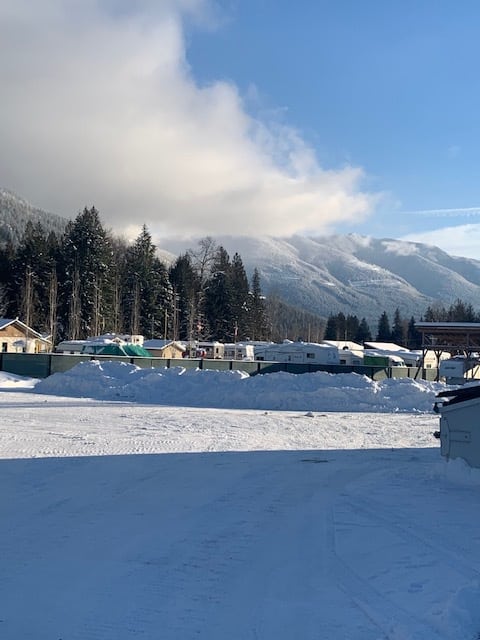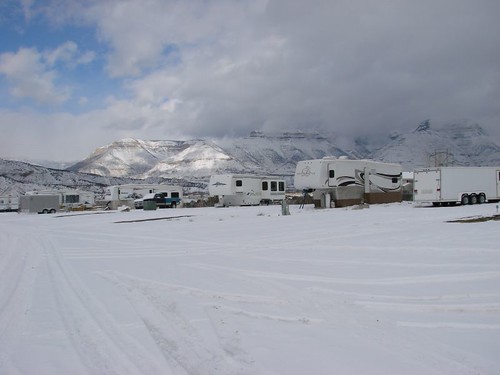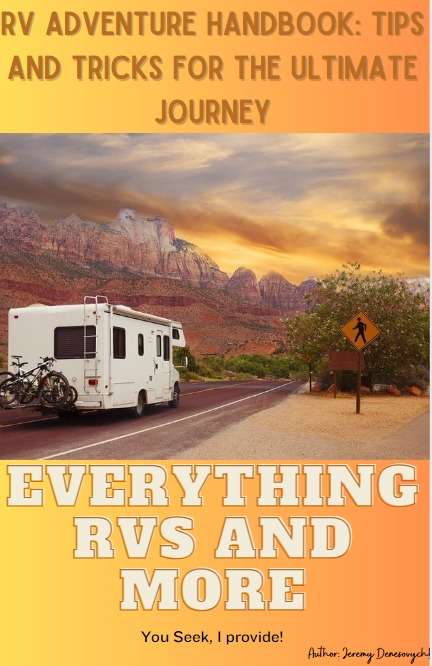Affiliate Disclosure: I earn commissions if you shop through the links below at no additional cost to you.
Last Updated on February 13, 2025 by Jeremy
Introduction: The Reality of Winter RV Life
A fresh blanket of snow covers the ground, and the temperature has dipped to -3°C overnight. You wake up to frozen waste valves, propane issues, and no extra blankets—a true winter RV nightmare.
For those new to stationary winter RV living, the learning curve is steep. But with proper preparation, the right gear, and a few hard-earned tricks, you can turn your RV into a warm, safe haven all season long.
This guide breaks down key winter RV survival strategies, from insulation and heating to water management and safety tips, ensuring you stay comfortable and secure no matter how cold it gets.

Main Tip #1: Plan Ahead
Winter doesn’t play fair—temperatures drop fast, pipes freeze, and storms can roll in without warning. Before committing to winter RV living, it’s crucial to prepare in advance.
What You Need to Plan For:
- Weather Forecasts: Monitor long-term forecasts using apps like The Weather Network or AccuWeather.
- Location: If possible, stay stationary in a full-hookup campground—boondocking in extreme cold is a whole different beast.
- Emergency Supplies: Stock up on extra propane, blankets, food, and backup heating options before the first major freeze.
- RV Condition Check: Inspect seals, slide-outs, and vents before temperatures drop, fixing any leaks or drafts.
✅ Pro Tip: If you’re traveling in the winter, always have an alternative route planned in case of road closures due to snowstorms.
Main Tip #2: Stay Stationary in Winter

If you’re not chasing the sun down south, staying stationary for the winter is the safest option. Moving an RV frequently in freezing temperatures increases the risk of water line failures, frozen tanks, and wind damage.
Winterizing Your Stationary RV
🔹 Protect Exposed Parts
- A/C Unit Cover: Prevents leaks and cold drafts.
- Window Insulation: Use exterior reflective foil insulation instead of interior coverings to prevent condensation.
🔹 Heat Tape & Pipe Insulation
- Insulate all exposed pipes under the RV to prevent them from freezing.
- Use heat tape on your water hose and sewer lines.
🔹 RV Skirting
Skirting your RV prevents cold air from circulating underneath, helping maintain warmer interior temperatures.
Best RV Skirting Options:
✔ Foam Insulation Boards (2” Styrofoam sheets) – Budget-friendly and highly effective.
✔ Plywood or Pallets – Sturdy and wind-resistant but requires effort to set up.
✔ Hay Bales – Great insulation but attracts rodents (not recommended unless desperate).
✔ Foil Double-Bubble Insulation – Quick to apply using white tuck tape or aluminum duct tape.
✔ Pre-Made Winter Tarps – Costly but highly efficient and removable for spring storage.
Want a real-world look at RV skirting solutions? Check out my YouTube Shorts video on how to skirt your RV for winter survival:
📺 Watch here
✅ Pro Tip: Fully skirted RVs can be 10–15°C warmer underneath, reducing strain on your heating system.
Main Tip #3: Managing Water & Drainage
One of the biggest winter RV challenges is keeping water lines, hoses, and tanks from freezing.
How to Keep Your RV Water System Running in Winter
🔹 Freshwater Tank
- Flush RV antifreeze through your water lines before winter hits.
- Keep your fresh water tank full to prevent freezing and consider a tank heater.
🔹 Water Hose
- Use a Camco Heated Water Hose or wrap a standard hose in heat tape & pipe insulation.
- Cover all exposed hose connections.
🔹 Grey & Black Tanks
- Insulated sewer hoses can be left connected year-round.
- If using a standard hose, dump tanks every 2–3 days to avoid frozen waste.
- Pour a cup of RV antifreeze into the grey & black tanks after each dump to prevent ice buildup.
✅ Pro Tip: Turn off hydrant valves on water hookups during extreme cold to prevent freezing at the source.
Main Tip #4: Keeping Your RV Warm Inside
Your heating system is your lifeline. Without proper preparation, your RV can feel like an icebox when temperatures drop below freezing.
Best Heating Strategies for Winter RV Living
🔹 Propane Furnace (Primary Heat Source)
- Always keep extra propane tanks on hand—a 30 lb. tank can burn through in 3–5 days in extreme cold.
- Regulators can freeze due to humidity buildup—install a propane tank heater or wrap them in insulation.
🔹 Electric Heaters (Backup Heat Source)
- Use 1–3 space heaters depending on your RV size.
- Oscillating tower heaters work well for large spaces, while ceramic heaters are great for focused warmth.
🔹 Dehumidifiers
- With heat comes moisture, and excess condensation can cause mold inside your RV.
- Run a dehumidifier or use moisture absorbers like DampRid.
🔹 Heated Underbelly (If Equipped)
- If your RV has a heated underbelly, keep it on continuously during cold spells.
- If not, place a small space heater or heat lamp underneath in extreme temperatures.
✅ Pro Tip: Keep a heat source near your RV pipes & water pump—even heated underbellies can freeze without additional heat support.
Main Tip #5: Winter RV Safety Must-Knows

Winter brings hidden risks that every stationary RVer must prepare for.
Critical Winter Safety Tips
✔ Have an Escape Plan – Make sure windows, doors, and vents aren’t blocked by snow or ice.
✔ Clear Snow Around Propane & Furnace Vents – Blocked vents = carbon monoxide buildup.
✔ Stock Extra Propane & Firewood – Propane shortages happen every winter. Be prepared.
✔ Monitor Weather Alerts – Know when storms are coming and have an emergency plan.
✔ Stock Up on Food & Water – Extreme weather can make travel impossible—prepare to be self-sufficient.
✔ Keep Heavy Snow Off Your Roof – Use a snow rake to prevent roof damage & leaks.
✔ Keep Extra Blankets & Warm Clothes Ready – A backup layer of warmth can be a lifesaver in a propane outage.
✅ Pro Tip: Invest in a battery-operated carbon monoxide detector—your furnace can leak gas inside your RV without warning.
Final Thoughts: Surviving & Thriving in a Winter RV
Winter RV living isn’t for the faint of heart, but with the right prep, it can be an amazing experience.
Quick Recap of Winter RV Essentials:
✔ Plan Ahead – Weather, location, supplies.
✔ Stay Stationary – Moving in winter increases risks.
✔ Insulate & Skirt – Keep the cold out and the warmth in.
✔ Manage Water Properly – Prevent frozen pipes & tanks.
✔ Keep Your RV Heated – Propane, electric heaters, dehumidifiers.
✔ Stay Safe – Monitor weather, clear snow, have emergency backups.
Now, I want to hear from you! What’s your best winter RV survival tip? Share your experience in the comments—your advice could help the next camper stay warm & safe.




.jpg/:/cr=t:5.56%25,l:0%25,w:100%25,h:88.89%25/rs=w:1240,h:620,cg:true)



Leave a Reply